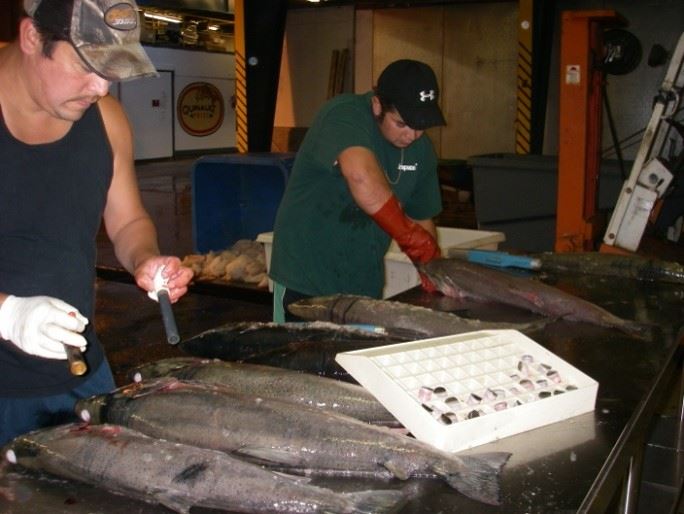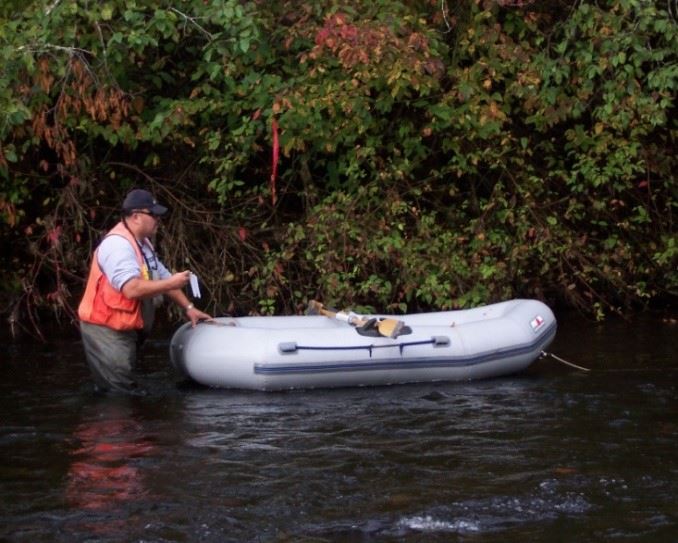Salmon - River Fisheries
The Quinault Indian Nation relies on salmon for food, recreation, jobs, and cultural traditions. The harvest of salmon and steelhead returning to their spawning grounds is central to the Nation's well-being.
The Quinault Department of Fisheries (QDFi) provides technical support to Quinault fisheries policy and technical representatives in the process to create annual management plans for each species. The resultant plans for fall salmon and winter steelhead seasons for each of the rivers within QIN Usual & Accustomed fishing areas establish fishing schedules (regulations). Fisheries resource conservation and treaty/non-treaty sharing objectives in off-reservations areas are documented.
Species
In the fall, Quinault fishers in the Queets, Quinault, and off-reservation fishing grounds may land Chinook salmon (King, Oncorhynchus tshawytscha), Coho salmon (Silver, Oncorhynchus kisutch), and Chum salmon (dog or calico, Oncorhynchus keta). In the winter, Steelhead (Oncorhynchus mykiss) become prevalent in all areas. White sturgeon (Acipenser transmontanus) may be caught in Grays Harbor and the mouths of the coastal rivers in winter. Quinault River Sockeye (Blueback), a strain of Oncorhynchus nerka, is one of seven genetically distinct populations of sockeye in the Pacific Northwest. In the spring, Quinault River sockeye return from the ocean and spend three to 10 months in Lake Quinault prior to moving on to spawn in the Upper Quinault River and its tributaries. These fish are seldom caught anywhere but the lower Quinault River. Pink (humpies, Onchorhynchus gorbuscha), are seldom caught in the in-river fisheries but occasionally are landed by treaty troll fishers.
All species are monitored closely by QDFi staff and annual management plans are followed to ensure harvest is regulated for the benefit of the species as well as the benefit of the Nation's fishers.
Sampling
QDFi staff are charged with sampling a percentage of the landed catch of salmon, steelhead, and sturgeon each week. This sampling documents size, age, and hatchery/wild status by collecting length/weight data, age structures (otoliths or scales), and recovering coded wire tags detected electronically in sampled fish. The age structures and coded wire tags are "read" and their values recorded. Annual comparison of these data with the overall harvest data for each area allow scientists to obtain a picture of the year's population.
Spawning Ground Surveys
Members of the Technical Support team spend their autumn-into-winter days walking and rafting the upper reaches of the QIN Reservation streams to observe and count salmon redds (egg nests) and salmon carcasses on the stream banks. The data collected on these surveys are the basis for the estimate of numbers of each species that escape the fishery and thereby provide the natural young of the year. Several seasonal technicians are hired each year to help with this activity.
-
Arleen Kramer
Production, Planning, Expediting AdministratorPhone: 360-276-8215 Ext. 1810
-
Tyler Jurasin
Operations Section ManagerPhone: 360-276-8215, ext. 7472